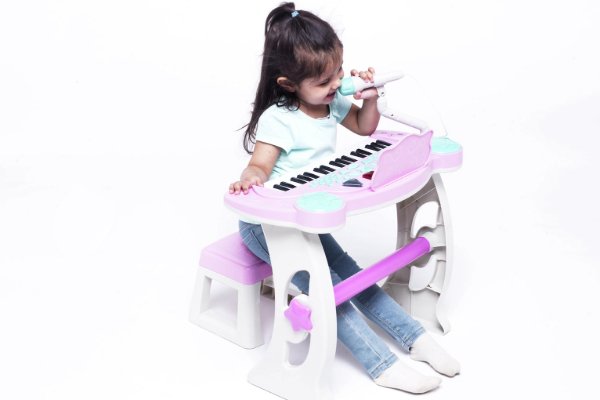Musical instruments for kids
Choosing the right musical instrument for your child can be both exciting and challenging. With a plethora of options available, it's important to make an informed decision that will nurture your child's interest and support their development, all while helping them have fun and explore their creative side. This guide will help you navigate the process by answering some common questions parents have when choosing a musical instrument for their kids.
&poi={$this.metadata.pointOfInterest.x},{$this.metadata.pointOfInterest.y},{$this.metadata.pointOfInterest.w},{$this.metadata.pointOfInterest.h}&scaleFit={($this.metadata.pointOfInterest.x>0)?$sfpoi:$sfcenter}&sm=aspect&aspect=2:1&sfcenter=center&sfpoi=poi&qlt=50&fmt=auto&noiser=0&fmt.jpeg.interlaced=true&fmt.jp2.qlt=40&)
Carousel
?w=auto&qlt=50&fmt=auto&noiser=0&fmt.jpeg.interlaced=true&fmt.jp2.qlt=40&)
What is the best age to start musical instruments?
There's no one-size-fits-all answer, but many children show readiness for exploring music between the ages of 3 and 8. Younger children of 1-2 years might enjoy simple instruments like shakers or tambourines, but as they grow they will be ready for more complex instruments like keyboards or ukuleles. But the most important factor in deciding whether your child is ready to take on learning an instrument is their interest level. No matter their age, if they’re showing a musical passion then it should be nurtured.
?w=auto&qlt=50&fmt=auto&noiser=0&fmt.jpeg.interlaced=true&fmt.jp2.qlt=40&)
How to Choose an Instrument for Kids
Consider the following factors when selecting musical toys and instruments for your child:
- Pay attention to which instruments or sounds your child is naturally drawn to.
- Make sure that the instrument suits your child's size and strength.
- Starting with simpler instruments that can build their confidence.
Carousel
?w=auto&qlt=50&fmt=auto&noiser=0&fmt.jpeg.interlaced=true&fmt.jp2.qlt=40&)
What musical instrument should a child start with?
Starting with a simple instrument can be key to nurturing a lifelong love for music. Percussion instruments like small drums, tambourines, or xylophones are great for young beginners, as they are easy to play and help develop a sense of rhythm and coordination. These instruments allow children to explore their musical expression without needing complex techniques, making them perfect for sparking early interest.
As they grow, you might consider moving them onto stringed instruments or keyboard instruments for slightly older children. These instruments require a bit more dexterity and hand-eye coordination, making them a great next step. The goal is to help children build confidence by starting with an instrument that feels approachable and fun, encouraging them to keep playing as they grow.
?w=auto&qlt=50&fmt=auto&noiser=0&fmt.jpeg.interlaced=true&fmt.jp2.qlt=40&)
What is the easiest instrument for a child to learn?
The keyboard and ukulele are often recommended for beginners due to their straightforward learning curves. The keyboard introduces kids to piano basics and musical theory, while the ukulele's small size and fewer strings make it manageable for little hands. Both instruments require more skill and attention than basic toys like shakers and hand drums, encouraging your child to engage in learning and improving their musical ability.
?w=auto&qlt=50&fmt=auto&noiser=0&fmt.jpeg.interlaced=true&fmt.jp2.qlt=40&)
What is the hardest instrument to play for kids?
Some instruments require significant skill, patience, and fine motor coordination, making them more challenging for young children. Instruments like the violin and cello call for a specific bowing technique and accurate finger positioning, which can be difficult for smaller hands to master. However, the unique and expressive sound of string instruments can be very rewarding for children who are willing to take on the challenge.
Other challenging instruments include woodwinds like the clarinet or flute, which require both breath control and finger coordination. For a child with a natural inclination or interest in a more complex instrument, support and encouragement are key. With patience and a willingness to practice, many children can master these instruments over time, and they’ll learn perseverance along the way.
Carousel
?w=auto&qlt=50&fmt=auto&noiser=0&fmt.jpeg.interlaced=true&fmt.jp2.qlt=40&)
What instrument Is best for brain development?
The piano is often recommended for its positive impact on children’s brain development. Playing the piano involves using both hands independently of one another, which means the brain has to coordinate multiple tasks at once. This strengthens neural connections, improving memory, problem-solving, and spatial reasoning. Learning piano also introduces children to the basics of musical theory, like reading notes and rhythms, which further improves their cognitive skills.
String instruments like the guitar or violin can have similar benefits, especially for older children, as they both require hand-eye coordination and memorisation of notes and chords. Studies have shown that musical training can even boost academic performance, so starting on an instrument that is known for its cognitive benefits could be an investment in both their musical and mental development.
?w=auto&qlt=50&fmt=auto&noiser=0&fmt.jpeg.interlaced=true&fmt.jp2.qlt=40&)
How many instruments should a child learn?
It’s generally best to start with one instrument and allow your child to develop a strong foundation before moving on to another. Learning a single instrument helps children build key skills like reading music, developing their rhythm, and understanding musical structure. Once they have a level of comfort and proficiency in their first instrument, they may naturally show interest in learning more, which can expand their musical abilities and enhance their overall experience.
Many professional musicians advocate for exploring more instruments after a child has a solid grounding in one. So if your child shows interest, adding a complementary instrument (for example learning both piano and guitar) can deepen their musical understanding and keep them engaged. However, there’s no need to rush or overburden them. Encouraging children to enjoy the process and play at their own pace is the most important factor, as it will mean they continue to enjoy their practice and are more likely to want to continue as they grow older.
Carousel
?w=auto&qlt=50&fmt=auto&noiser=0&fmt.jpeg.interlaced=true&fmt.jp2.qlt=40&)
What instrument is good for ADHD?
For children with ADHD, instruments that offer both physical engagement and rhythmic consistency can be particularly beneficial. Percussion instruments like drums or djembe drums are great choices, as they allow kids to channel their energy while providing structure through rhythmic patterns. Drumming can also improve focus and concentration, giving children a productive way to direct their energy.
Wind instruments like the recorder can also be suitable, as they require breath control and coordination, which can help with impulse regulation and fine motor skills. Music can provide a creative outlet and serve as a positive coping tool, helping children with ADHD to manage their emotions and build their concentration. Encouraging them to experiment with different instruments may also help them find the one they connect with most.
?w=auto&qlt=50&fmt=auto&noiser=0&fmt.jpeg.interlaced=true&fmt.jp2.qlt=40&)
What instrument is good for Autism?
Music can be incredibly therapeutic for children with autism, as it offers sensory stimulation and a means of expression. Instruments that provide predictable sound and tactile feedback can be beneficial. Musical toys and percussion instruments such as xylophones, hand drums, or maracas allow children to create sound fairly easily, which can be both comforting and fun. The rhythmic and repetitive nature of percussion can be especially soothing for children who thrive on structure and predictability.
Wind instruments like the harmonica or flute may also be beneficial, as the act of blowing can provide sensory satisfaction and promote deep breathing. Music therapy has shown positive effects on social skills and emotional expression in children with autism, so finding an instrument they enjoy can support their growth and happiness. Experimenting with a few different instruments may help you identify which one your child feels most comfortable with.
?w=auto&qlt=50&fmt=auto&noiser=0&fmt.jpeg.interlaced=true&fmt.jp2.qlt=40&)
Which instrument is good for mental health?
Playing an instrument can have a significant impact on a child’s mental health, giving a healthy way to express their emotions and cope with stress. The guitar and piano are often recommended for their soothing sounds and versatility. Both instruments allow children to play melodies that inspire positive emotions, and the act of creating music can also promote relaxation.
The piano, in particular, has a reputation for being therapeutic. Many children find joy in playing familiar tunes or experimenting with new ones. The focused attention that is needed for practice can be meditative, helping children manage any feelings of anxiety or restlessness. Encouraging children to explore music as a tool for self-expression can improve their emotional resilience and bring a sense of accomplishment that supports their overall mental wellbeing.
Choosing the right instrument is a personal journey for both you and your child. By considering their interests and needs, you can find an instrument that brings joy and also supports their overall development. For a wide selection of age-appropriate and affordable options, visit our musical toys and instruments section.

?w=auto&qlt=50&fmt=auto&noiser=0&fmt.jpeg.interlaced=true&fmt.jp2.qlt=40&)
?w=auto&qlt=50&fmt=auto&noiser=0&fmt.jpeg.interlaced=true&fmt.jp2.qlt=40&)
?w=auto&qlt=50&fmt=auto&noiser=0&fmt.jpeg.interlaced=true&fmt.jp2.qlt=40&)
?w=auto&qlt=50&fmt=auto&noiser=0&fmt.jpeg.interlaced=true&fmt.jp2.qlt=40&)
?w=auto&qlt=50&fmt=auto&noiser=0&fmt.jpeg.interlaced=true&fmt.jp2.qlt=40&)
?w=auto&qlt=50&fmt=auto&noiser=0&fmt.jpeg.interlaced=true&fmt.jp2.qlt=40&)
?w=auto&qlt=50&fmt=auto&noiser=0&fmt.jpeg.interlaced=true&fmt.jp2.qlt=40&)
?w=auto&qlt=50&fmt=auto&noiser=0&fmt.jpeg.interlaced=true&fmt.jp2.qlt=40&)
?w=auto&qlt=50&fmt=auto&noiser=0&fmt.jpeg.interlaced=true&fmt.jp2.qlt=40&)
?w=auto&qlt=50&fmt=auto&noiser=0&fmt.jpeg.interlaced=true&fmt.jp2.qlt=40&)